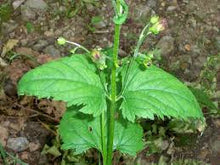The small snapdragon-like flowers of Figwort are quite inconspicuous: you’d never imagine that bees would love them so much. In my diverse gardens, the only other plant that comes close to attracting that many bees is Phacelia tanecetifolia.
Figwort is also a favourite plant of butterflies, hummingbirds and beneficial wasps. It is a widespread herbaceous perennial in the Northern Hemisphere that grows to about 3 feet/1 metre high in its first year and over 6 feet in succeeding years. It flowers from June to September, with the seeds ripening from July to September. Its leaves have a beautiful violet tinge when they first appear quite early in spring.
The name Scrophularia comes from scrofula, a form of tuberculosis of the lymphatic glands that Figwort was historically used to treat. The roots of Figwort have a long history of use for skin problems, sprains, swellings, burns and inflammation. Figwort also has been a well-known remedy for sore throat, swollen tonsils and red, swollen eyes.
Also called Woodland Figwort and Knotted Figwort, it is a very esteemed yin tonic known as Xuan Shen in Traditional Chinese Medicine. Its roots are employed to “cool the blood” and to clear inflammatory and infectious conditions, including psoriasis and eczema..
Figwort is a very hardy, low-maintenance, drought-tolerant and rewarding perennial. As with so many plants, seed can be started 8-10 weeks before the last frost and transplanted out once the weather has warmed. However, as with most perennial herbs, it can be started at practically anytime during the growing season to be placed in its permanent position before the weather turns cold. If started early though, it will flower the first year. It is happy in full sun or part shade and it best thinned to 1-2 feet apart. It tolerates fairly wet soils and is hardy to at least -15 degrees C. Clumps can be separated and your plot expanded after 3-4 years. It is deer resistant.
After the flowers fade, the Figwort seeds develop in teardrop shaped seed capsules that brown and dry. They are easy to gather and clean. The seeds are easy to germinate as well but should be only lightly pressed into your starting mix.




